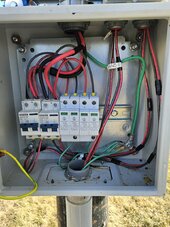@Zwy
As you recommend I plugged my numbers into the Midnight Solar Calculator, here was the result:
Rated PV Array Power: 12740 Watts
Anticipated Array Power @ 40C: 12071 Watts
Rated PV Array Current: 43.68 Amps
I think if you have 43A of PV current you won't find a charge controller that is rated for 43A unless you using a charge controller that has a low VOC rating like 150V. Common Victron charge controllers are the 150V and 250V versions and thus you will see users combine strings due to the lower max VOC rating.
My assumption is you are combining strings.
My rule is this, get VOC up with panels in series to the max without exceeding the charge controller VOC rating. String current can be as little as one string, which is the Isc of a panel or if combining 2 strings, it would be double the Isc of the panel. I prefer single strings without any combining. It will depend on the panels chosen, whether overpaneling is desired (which I don't do) and the charge controllers being used.
Take the array for my house as an example. 530W panels, VOC is around 48 to 49V, Isc is around 10 to 13A. I run 8 panels in series, that is around 400VOC and a single string is around 10 to 13A. With a 5000W rated charge controller, that comes in as a good fit. I've seen as high as 4.6Kw from a single string and I don't have any clipping. I run 2 charge controllers, an 8S string on each charge controller.
I don't what panels you are using or the charge controller but maybe you should list those so we can see what you are using. You can run multiple charge controllers on the same battery bank, each can pull the power from a string or a pair of combined strings. You can have 2, 3, 4, 5 or more. If you are using an AIO inverter that has multiple MPPT's, it is the same thing.
Battery Charging Current @ 57.6 V: 221.2 Amps
How big is the battery bank?
VMP (Maximum Power Point Voltage) : 291.9 Volts
VOC (Open Circuit Voltage): 346.5 Volts
VMP @ -15 C°: 332.5 Volts
VOC @ -15 C°: 392 Volts
Seems like the IMO disconnects you're recommending are the safest option. Checking those now.
IMO is rated for PV disconnect under load. It was designed for this purpose. Read this
entire thread. I mount the IMO just like Johnny does with a chase nipple and Myers hub. Inside the Vevor box it looks like this.

I run a breaker on each string and an SPD. There is also the green EGC that is from the panel frames. I showed this in one of my videos.




